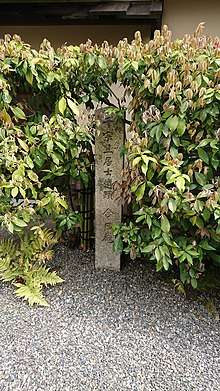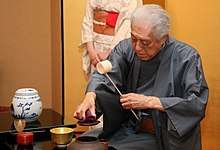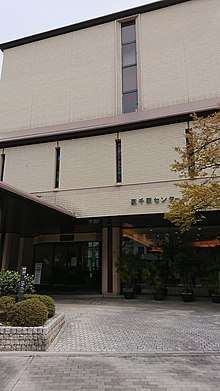Urasenke
Urasenke (裏千家) is one of the schools of Japanese tea ceremony. Along with Omotesenke and Mushakōjisenke, it is one of the three lines of the Sen family descending from Sen no Rikyū, which together are known as the san-Senke or "three Sen houses/families" (三千家).[1]

The name "Urasenke", literally meaning "rear Sen house/family," came into being as a natural occurrence, because of the location of the homestead of this line of the family in relation to what was originally the front (omote) house of the Sen estate.[2] This applies equally to the name "Omotesenke", literally meaning "front Sen house/family." The name "Mushakōjisenke" for the other of the three lines of the family derives from the fact that the family's homestead is located along Mushakōji street.
History
The three Sen houses derive from descendants of Sen no Rikyū, who was active during the Azuchi-Momoyama period and is the most historically important figure within Japanese tea ceremony.
Rikyū's hometown was Sakai, in the province of Izumi (in present-day Osaka prefecture). However, as his activities became centered in Kyoto, he kept a house in Kyoto. He also had his adopted son-in-law, Sen Shōan, who was married to his daughter Okame, move from Sakai to Kyoto, leaving his natural son, Sen Dōan, to tend the family home and business in Sakai. This represents the origin of the two branches of the Sen family (Senke) referred to as the Sakai-Senke and Kyō-Senke. The Kyō-Senke, headed by Sen Shōan, eventually settled in a house located on Ogawa Street, in the neighborhood of Honpō-ji (Kyoto) temple; the house and property representing the original Sen estate in Kyoto. Following the death of Rikyū, both Sen Dōan of the Sakai-Senke and Sen Shōan of the Kyō-Senke, inevitably caught up in the wrath of Toyotomi Hideyoshi which had been the reason for Rikyū's self-immolation, were in danger of also losing their lives, and so, to protect their homes and families, they went into hiding. After a number of months, however, they both were able to return home. In the end, Sen Dōan, back in Sakai, left no successors to carry on the Sakai-Senke. On the other hand, Sen Shōan, returning home to Kyoto, already had a son, Sen Sōtan, born between him and Okame, to succeed him as head of the Kyō-Senke.[3]

Sōtan had five offspring: the older two, Kan'ō Sōsetsu (?-1652) and Ichiō Sōshū (1605-1676), were his sons born between him and his first wife. After his first wife's death, Sōtan remarried, and between him and his second wife there were born his third son, Kōshin Sōsa (1613-1672), a daughter named Kure (dates uncertain), and his fourth son, Sensō Sōshitsu (1622-1697). Kan'ō Sōsetsu and Ichiō Sōshū began living independently when they were young men. Also, Sensō left the family as a young man, to apprentice under a local doctor named Noma Gentaku. Due to the untimely death of Noma Gentaku, however, Sensō returned home in 1645, and thereafter, with his father Sōtan's support, followed a course of life as a chanoyu expert, like his elder brother Kōshin Sōsa was doing as the apparent heir to the Sen house and its chadō tradition. Around the year 1646, when Sōtan was about 68 years old, he gave up his family headship to Kōshin Sōsa, and moved into quarters which had been built at the rear of the house, and which included a tiny tea hut, the Konnichian (今日庵, "Hut of This Day").[4] Sōtan's retirement quarters became Sensō's home base, and Sensō eventually became heir to that property.
Sōtan had found employment for his eldest son, Ichiō Sōshū, with the Maeda clan of the Kaga Domain, but Ichiō soon quit his position with the Maeda, and this led to Sōtan's disinheriting of Ichiō. On the other hand, Sōtan's second son, Kan'ō Sōsetsu, had been adopted by the Yoshioka family of lacquer-ware specialists in Kyoto, who were known by their business name, Yoshimonjiya. During this period, he went by the name Yoshioka Kan'uemon. In his later life, however, he reverted to the Sen family, established a tea room named "Kankyuan" at his residence on Mushakōji street, and began to follow a course of life as a chanoyu expert. With this, Rikyū's chanoyu ideals and legacy as carried forward by his direct descendants branched into the three lines of the Sen family referred to as the san-Senke.[5]
Before the Meiji Restoration (1868), the heads of the three families, respectfully, were in service as chadō magistrates under various daimyō, and received an adequate stipend from them. In the case of the family that eventually came to be known as the Urasenke, Sensō was in service to the Maeda clan of Kaga. During the following generations, the Urasenke family head also came to serve as chadō magistrate for the Hisamatsu clan of the Iyo Domain, in present-day Ehime prefecture, as well as caretaker for that family's Kyoto residence. The eleventh generation family head, Gengensai (1810-77), who was born as the fifth son of a minor daimyō named Matsudaira Noritomo of the Mikawa Okudono domain and married into the Urasenke family, also served the Owari branch of the Tokugawa family. With the fall of the Tokugawa shogunate (1868), however, the daimyō lost their positions, and the hereditary stipends which the three Sen families had been receiving came to an end. It was after this, and the loss of their positions serving the daimyō, that the Sen families established their iemoto system.[6]
The entire historical Urasenke estate, located in the Kamigyō-ku ward of Kyoto, is referred to by the name of its representative tea room, the "Konnichian."
Headmasters
All three lines of the Sen family share their first three generations. Sen no Rikyū is their mutual first generation; that is, their mutual family founder (祖). Sen Shōan is their mutual second generation. Sen Sōtan is their mutual third generation. Then, from the fourth generation, their family lineages divide. It is from the fourth generation that the heads of the three separate families came to carry the hereditary professional name which has been used by the successive heads of their respective family. The head (iemoto) of the Urasenke family and its school of chadō assumes the hereditary professional name Sōshitsu upon succession, to become officially referred to as Sen Sōshitsu. The present head is Zabōsai Genmoku Sōshitsu; he is the 16th generation in the line (Sen Sōshitsu XVI).

| Generation | name | religious pseudonym | ||
|---|---|---|---|---|
| 1st | Rikyū Sōeki (1522–91) | 利休 宗易 | Hōsensai | 抛筌斎 |
| 2nd | Shōan Sōjun (1546-1614) | 少庵 宗淳 | ||
| 3rd | Genpaku Sōtan (1578-1658) | 元伯 宗旦 | Totsutotsusai | 咄々斎 |
| 4th | Sensō Sōshitsu (1622–97) | 仙叟 宗室 | Rōgetsuan | 臘月庵 |
| 5th | Jōsō Sōshitsu (1673-1704) | 常叟 宗室 | Fukyūsai | 不休斎 |
| 6th | Taisō Sōshitsu (1694-1726) | 泰叟 宗室 | Rikkansai | 六閑斎 |
| 7th | Chikusō Sōshitsu (1709–33) | 竺叟 宗室 | Saisaisai | 最々斎 |
| 8th | Ittō Sōshitsu (1719–71) | 一燈 宗室 | Yūgensai | 又玄斎 |
| 9th | Sekiō Sōshitsu (1746-1801) | 石翁 宗室 | Fukensai | 不見斎 |
| 10th | Hakusō Sōshitsu (1770-1826) | 柏叟 宗室 | Nintokusai | 認得斎 |
| 11th | Seichū Sōshitsu (1810–77) | 精中 宗室 | Gengensai | 玄々斎 |
| 12th | Jikishō Sōshitsu (1852-1917) | 直叟 宗室 | Yūmyōsai | 又玅斎 |
| 13th | Tetchū Sōshitsu (1872-1924) | 鉄中 宗室 | Ennōsai | 圓能斎 |
| 14th | Sekisō Sōshitsu (1893-1964) | 碩叟 宗室 | Mugensai | 無限斎 |
| 15th | Hansō Sōshitsu (Sen Genshitsu) (b. April 19, 1923) | 汎叟 宗室 | Hōunsai | 鵬雲斎 |
| 16th (current iemoto) | Genmoku Sōshitsu (b. June 7, 1956) | 玄黙 宗室 | Zabōsai | 坐忘斎 |
Urasenke Foundation
The Urasenke Foundation (Japanese name, 一般財団法人今日庵, Ippan Zaidan Hōjin Konnichian) is an incorporated foundation originally registered by the Japanese government in 1949, during the era of the 14th-generation grand master, Tantansai. Its purpose is to preserve and foster the cultural heritage of Urasenke. Towards this end, among its major activities are the maintenance and management of the Urasenke estate and cultural assets, and the support of research and public education concerning the Way of Tea.[7] Its administrative office, together with that of the Urasenke Tankōkai Federation, is located within the five-story Urasenke Center building located a short distance west of the historical Urasenke compound.
Urasenke Center

Chadō Research Center
Konnichian Library
Branches
The Urasenke Tokyo Branch is officially called the Urasenke Tokyo Dōjō (裏千家東京道場, Urasenke Tokyo Training Center) in Japanese. It was originally established in 1957, in Tokyo's Chiyoda ward, and moved into its newly built quarters at its present location in the Ichigaya Kaga-cho section of Tokyo's Shinjuku ward in 1995. This Urasenke facility serves as the hub of the activities sponsored by the Urasenke head house in Japan’s capital. Oftentimes, the training courses and special events held at Urasenke Konnichian are also held here, for the convenience of participants living in eastern Japan. The main building contains replicas of the Totsutotsusai and Kan’untei tea rooms at Konnichian.[8] The Urasenke Tokyo Dōjō is the only Urasenke branch in Japan.
From the mid-1960s, Sōshitsu Sen XV (Hōunsai) began to dispatch qualified Urasenke chanoyu instructors to live overseas and, operating out of Urasenke Foundation branch offices or liaison offices, to teach the growing numbers of individuals who desired to pursue the practice of chado.[9] The dates and places to which the teachers were dispatched and thus an Urasenke branch or liaison office was established were as follows:[10]
- 1966, September. Hawaii (Honolulu), and Boston.
- 1967, September. New York
- 1969, August. Rome, Italy.
- 1972, June. Munich, Germany, when Urasenke donated a tea house named "Kanshoan" (閑松庵)to that city.
- 1973, February. Mexico (Mexico City).
- 1973, August. Hilo, Hawaii.
- 1974, March. Brisbane (liaison office), Australia.
- 1974, November. Peru (Lima).
- 1976, April. London, England; Dusseldorf, Germany; and Paris, France.
- 1976, August. Brazil (Sao Paulo).
- 1980, December. San Francisco, California.
- 1981, February. Seattle, Washington.
- 1986, May. Schwarzwald (liaison office; became Freiburg liaison office in 1997, April), Germany.
- 1991, March. Moscow (liaison office), Russia.
- 1991, May. Beijing (liaison office; became branch in 1993), China.
- 1992, August. Tianjin (liaison office), China.
- 1993, April. Vancouver (liaison office; became branch in 1994), Canada.
- 1993, August. Sydney, Australia.
- 1994, September. Washington D.C.
- 1997, April. Netherlands (liaison office).
Independently registered Urasenke Foundation corporations
The Urasenke Foundation of Hawaii, headquartered at the Urasenke Hawaii Branch, was established as a USA registered non-profit corporation in 1976.
The Urasenke Tea Ceremony Society, Inc, headquartered at the Urasenke Chanoyu Center, was established as a USA registered non-profit corporation in 1981, when the Urasenke New York Branch moved into the newly opened Urasenke Chanoyu Center, located at 153 East 69th St. in New York.
The Urasenke Foundation of California, headquartered at the Urasenke San Francisco Branch, was founded as a USA registered non-profit organization in 1994. It is generally known as Urasenke Foundation San Francisco.
Urasenke Tankōkai
The Urasenke Tankōkai (裏千家淡交会) is the membership organization for Urasenke teachers and students. It was initiated in 1940 by the fourteenth-generation head of Urasenke, Tantansai (1893-1964), with the aim of unifying and encouraging the practitioners of Urasenke chadō.[11] In 1953, It was registered by the Ministry of Education and Culture as a not-for-profit incorporated association (shadan hōjin). It is now registered as a not-for-profit general incorporated association (ippan shadan hōjin).[12] Its official registered name, as such, is Ippan Shadan Hōjin Chadō Urasenke Tankōkai (一般社団法人茶道裏千家淡交会). In English, it is referred to as the Urasenke Tankōkai Federation. Its stated aims are to ensure the standardization of the Urasenke chanoyu rules and tea-making procedures (temae), support research, encourage cooperation and exchange among all members, promote the practice of the principles layed down by the grand master, and expand the chadō population around the world. Also, it provides support for the purposes and activities of the Urasenke Foundation.[13]
In Japan, the organization is divided into seventeen districts comprising 165 chapters (shibu) and 2 sub-chapters (shisho). Each district has a liaison council for the Gakkō Chadō (Tea Training in the Educational System) program sponsored by the organization. There are also 167 groups belonging to the organization's Seinenbu, or "Youth Division." These three entities organize seminars, tea gatherings, conventions, and many other activities. The central office, serving to coordinate the programs and activities of all these, is located in the Urasenke Center building at Urasenke headquarters, Kyoto. Twice a year, in the spring and autumn, it calls together a national meeting of chapter presidents, to decide upon general policies and activities. In 1999, the International Division of the Urasenke Foundation was moved under the umbrella of this office, effectively extending the organization to overseas regions. Currently there are 92 official Chadō Urasenke Tankōkai associations spread over 37 countries outside Japan.[14]
Gakkō Chadō
Seinenbu
The Urasenke Tankōkai Seinenbu (裏千家淡交会青年部), or Urasenke Tankōkai Youth Division, is an organization for Urasenke chadō enthusiasts under the age of fifty. It was initiated in 1950 by the then Urasenke 15th-generation iemoto-to-be, Sen Sōkō, aiming to muster the combined power of Urasenke's youths toward rebuilding the war-torn nation. Its creed is "Train (修練) in order to better oneself; Serve (奉仕) your community; Friendship (友情) toward the world and among members." At first, the organization was called Seinenkai. This name was changed to Seinenbu in 1963. The organization's first chapters were established in Kure and Hiroshima in May, 1950. In 1966, the organization held its first National Convention, at the Kyoto International Conference Hall, at which there were over 2,200 attendees. In 1974, the organization's first chartered Urasenke Youth Ship (裏千家青年の船) friendship mission, with 418 participants, sailed to Okinawa and Hong Kong.[15]
Urasenke Gakuen
The Urasenke Gakuen Chadō Senmon Gakkō (裏千家学園茶道専門学校), or "Urasenke Gakuen Professional College of Chadō," is generally known as the Urasenke Gakuen. It is located on the same neighborhood block as the Urasenke home in Kyoto, and is the only accredited school in Japan specializing in chadō education. It had its start in 1962, as the Urasenke Chadō Kenshūjō (裏千家茶道研修所), or "Urasenke Chadō Training Institute,"[16] run by Urasenke's incorporated foundation, Zaidan Hōjin Konnichian (known in English as the Urasenke Foundation). In 1971, its name was changed to "Urasenke Gakuen," and in 1976, its name was changed again, to "Urasenke Gakuen Chadō Senmon Gakkō." In 1983, it had its new start as a registered educational foundation (学校法人),[17] and was formally accredited as a professional college by the Ministry of Education.
The number one characteristic of this professional college is that it is a chadō training center directly connected to the Urasenke Iemoto. The current Chairman of the Urasenke Gakuen Educational Foundation, and Principal of the Urasenke Gakuen Professional College, is Masako Sen,[18] who is the wife of Urasenke Iemoto Sōshitsu Sen XVI.
In addition to its regular three-year course, which is referred to as the chadō-ka (茶道科) and provides a basic, comprehensive chadō education, it also has a separate one-year course and a graduate course referred to as the kenkyūka (研究科, "research course").[19]
Furthermore, the Urasenke Gakuen has a non-Japanese students division called the "Midorikai" (lit., "green group"). The Midorikai study program is an intensive one-year program in which the students are provided with lectures and other instruction in English.[20]
Urasenke in popular culture
- The Choose Your Own Adventure book: Mystery of Ura Senke (nº 44), by Shannon Gilligan, deals with the theft of one of the Urasenke school's most famous tea ceremony bowls, worth millions of yen on the black market. The protagonist and their friend Kenichi Doi, whose older brother Takashi is an Urasenke school apprentice, start investigating the case.[21]
References
- Sen, Genshitsu; Sen, Soshitsu (2011). Urasenke Chado Textbook. Kyoto: Tankosha Publishing Co. p. 200. ISBN 978-4-473-03696-4.
- JTBの新日本ガイド15:京都
- Sen Sōsa, Sen Sōshitsu, Sen Sōshū supv. eds, Rikyū Daijiten (利休大辞典, "Rikyū Encyclopedia") entries for "Sakai Senke" and "Kyō-Senke". Tankosha Pub. Co., 1989. ISBN 4-473-01110-0.
- Iguchi Kaisen, et. al., supervising eds., Genshoku Chadō Daijiten (原色茶道大辞典, "Color-illustrated Chadō Encyclopedia"), entry for "Sen no Sōtan." Tankosha Pub. Co., 1975. ISBN 4-473-00089-3.
- Rikyū Daijiten entry for "Sōtan no tōjyō" ("Sōtan enters the stage"), p. 114.
- Chanoyu Quarterly no. 73, "The Diffusion of the Way of Tea" p. 5-6. Urasenke Foundation, 1993. ISSN 0009-1537.
- Urasenke Konnichian English website page "Urasenke Foundation", at http://www.urasenke.or.jp/texte/organ/konnichian/index_kon.html. Retrieved 4.13.2020.
- The Urasenke Chado Tradition color-illustrated 38-page pamphlet. Kyoto: Urasenke Foundation. December, 2019 printing.
- The Urasenke Chado Tradition.
- Grand Master Soshitsu Sen XV's Fifty-year Road Towards the Internationalization of the Way of Tea. Kyoto: Chado Urasenke Tankokai, Inc., 2001.
- Urasenke Konnichian English website page "The Urasenke Legacy," entry for "14th Generation," at http://www.urasenke.or.jp/texte/legacy/lineage1.html. Retrieved 4.04.2020.
- Urasenke Konnichian Japanese website page "Ippan Shadan Hojin Chado Urasenke Tankokai," at http://www.urasenke.or.jp/textc/tan/index.html. Retrieved 4.04.2020.
- Urasenke Konnichian English website page "Urasenke Tankokai Federation," at http://www.urasenke.or.jp/texte/organ/tankokai/index_tan.html. Retrieved 4.04.2020.
- Urasenke Konnichian English website page "Urasenke Tankokai Federation," at http://www.urasenke.or.jp/texte/organ/tankokai/index_tan.html. Retrieved 4.04.2020.
- Urasenke Konnichian Japanese website Seinenbu page, at http://www.urasenke.or.jp/textc/tan/seinen/aboutus/outline/index.htm. Retrieved 4.13.2020.
- Urasenke Konnichian English website category "Urasenke Accredited Colleges," at http://www.urasenke.or.jp/texte/uac/gakuen.html. retrieved 3.23.2020
- Kyoto Daijiten (京都大辞典, "Kyoto Encyclopedia") entry for "Urasenke Gakuen." Tankosha Pub. Co., 1984. ISBN 4-473-00885-1
- Kyoto no senmongakkō gaido ("Guide to the professional schools in Kyoto") website page about the Urasenke Gakuen Chadō Senmon Gakkō, at http://www.kyosen.or.jp/school/2/. retrieved 3.24.2020
- Urasenke Konnichian Japanese website category "Urasenke Gakuen Chadō Senmon Gakkō," at http://www.urasenke.ac.jp/school/index.html. retrieved 3.23.2020
- Urasenke Konnichian English website category "Urasenke Accredited Colleges," subcategory "Midorikai," at http://www.urasenke.or.jp/texte/uac/gakuen.html. retrieved 3.23.2020
- "Item - The Mystery of Ura Senke - Demian's Gamebook Web Page". gamebooks.org. Retrieved 2019-10-04.
- "SEN Soshitsu XVI, Iemoto" in Urasenke website.
- "The Urasenke Legacy" in Urasenke website.
- "Konnichian--The Urasenke Home" in Urasenke website.
- Urasenke Chadō Textbook. Supervising Eds., Genshitsu Sen and Sōshitsu Sen (Kyoto, Tankosha Publishing Co., 2011).